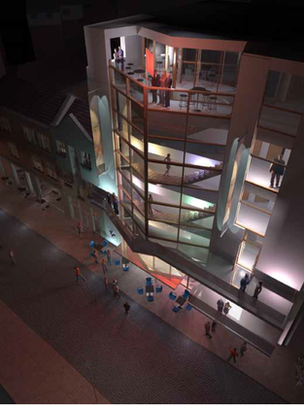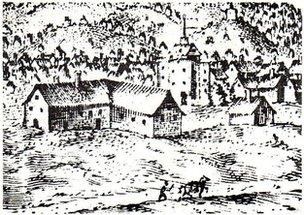New theatre to rise at site of Shakespeare playhouse
- Published

An image submitted to Hackney planning services of the proposal for the site of the Theatre
Planning permission has been granted to build a theatre on the site of a playhouse where the young William Shakespeare worked.
A six-storey theatre and cafe will be built above the remains of the what was known to the Bard as simply "The Theatre".
Visitors will be able to peer down to the foundations through glass panels in the ground floor.
The remains were found in Shoreditch, east London, during a 2008 dig.
The Theatre opened to audiences in 1576. A year later, another playhouse, the Curtain, was opened nearby.
Both were polygonal wooden structures like the reconstructed Globe Theatre on London's South Bank.
Both theatres were built outside the city walls after players were formally expelled from London in 1575 to protect against disease and poor morals.
Shakespeare is believed to have acted on both stages after arriving in London from Stratford, and early plays, including Romeo and Juliet, were performed at the venues.
"This wooden O", cited in the Prologue of Henry V, is believed to refer to the Curtain.
The scheme for The Theatre comes from the Belvedere Trust and is designed by Cambridge-based architects Bland Brown and Cole.
Neil Bowdler reports on development plans for the two Shakespearian theatres
Neither architect nor client would comment on the scheme when contacted by the BBC, but in a submission to the planning authorities, external of Hackney Council, they state the building will consist of a "new, purpose-built three-level theatre of exceptional quality".
"The building will also include permanent viewing of the historical artefacts found on the site, including the original Theatre remains," they add.
A previous application for a four-storey building was approved in 2009, but the new design will create a theatre with a larger capacity and enable the display of the archaeological remains at ground-floor level.
Curtain plans
Another mixed-use scheme has been proposed for the site of the Curtain, remains of which were discovered in a goods yard behind a pub in Shoreditch in 2011.
Dubbed the Stage, the project by Plough Yard Developments and designed by architects Pringle, Brandon, Perkins and Will, will see the archaeological remains put under glass at the centre of a new public plaza and performance space.

This image from about 1600 is thought to show the Curtain (with a flag in the background)
Visitors will be able to visit the remains close up, and a museum will be built.
To the edges of the new plaza, will be office space and a 40-storey residential tower block. A disused section of a railway viaduct on the site will be converted into gardens.
The application is scheduled to go before a Hackney Council committee in April.
Lead architect John Drew told the BBC: "First of all we want to fully discover the theatre and bring it back to life.
"We want to place it at the heart of a scheme and the heart of a public space where people can come and see it and enjoy it and learn about it.
"You're going to see some areas of glass paving [in a courtyard] and when you walk across those, you can look down and see the Elizabethan theatre below you. It's going to be living history."

An image of the proposal for the site of Shakespeare's Curtain theatre in Shoreditch
Marc Zakian, a tour guide and Shakespeare expert, believes both The Theatre and the Curtain can put Shoreditch and the wider borough of Hackney on the international tourist map.
But he is calling for the development and operation of the sites to be fully co-ordinated, for the good of both visitors and the borough.
"This is a moment when you can tell the story of this young boy from Stratford, who with a glint in his eye, comes down to London, excited, inspired by the new theatres, the first actual proper theatre buildings that were opening.
"This is where he arrives on the edge of London. He doesn't start on Bankside, where the Globe is, he starts in Hackney. Shakespeare in Hackney - what a story that is. We really need to tell that story".